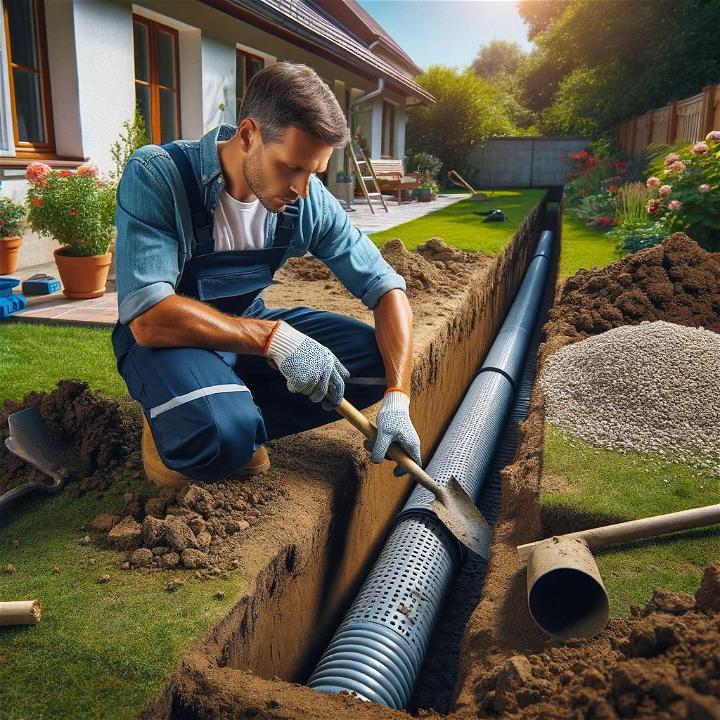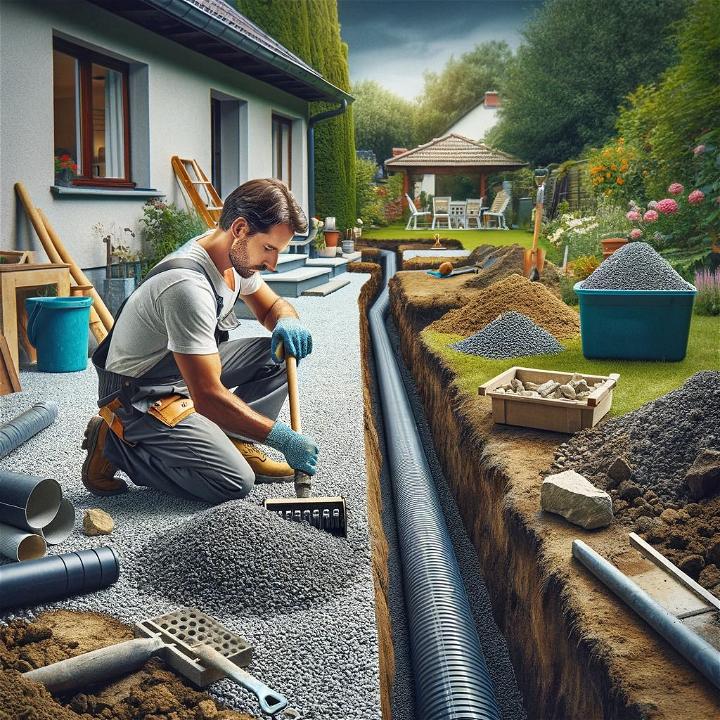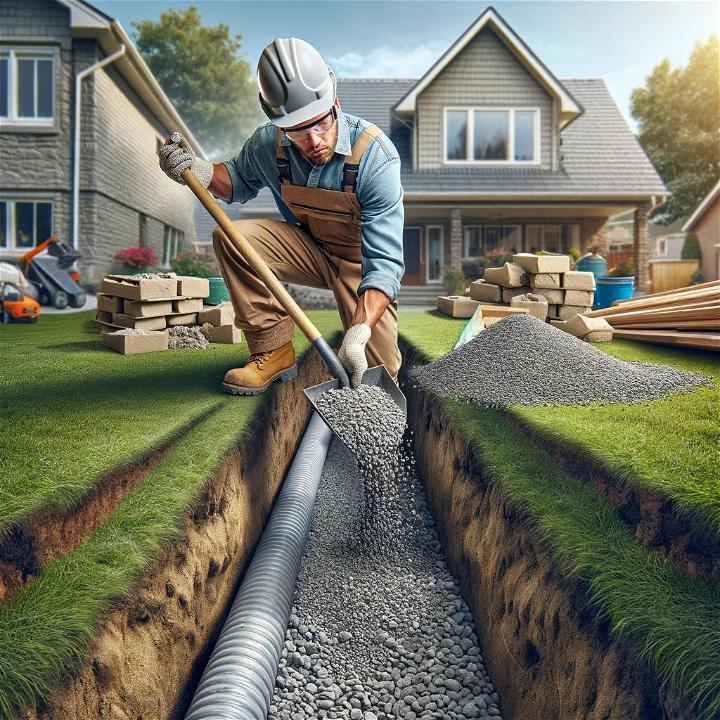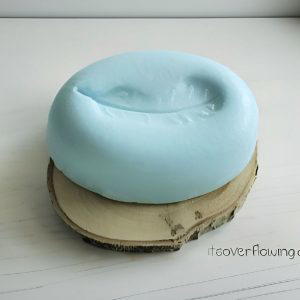A French drain is a crucial component in managing water flow around homes and landscapes. Essentially, a French drain is a trench filled with gravel or rock designed to redirect excess water away from an area. It may also include a perforated pipe known as a weeping tile to facilitate drainage more effectively.
The primary purpose of a French drain is to provide a pathway of least resistance for water to flow, preventing water buildup that could lead to soil saturation and potential flooding. Proper drainage systems, such as French drains, play a vital role in safeguarding properties against water-related damage and maintaining the integrity of landscapes.
By utilizing a French drain, homeowners can effectively manage water runoff, prevent waterlogging, and protect their property from potential water damage. Understanding the function and importance of a French drain is key to ensuring efficient water management and maintaining a healthy environment around your home.

Understanding a French Drain
French drains are a popular drainage solution designed to manage water flow effectively and protect properties from water damage. Let’s delve into the components and functionality that make French drains essential for any property.
Components of a French Drain
- Gravel: The base of a French drain is typically filled with gravel, which acts as a filter to prevent clogging and allows water to percolate more efficiently.
- Perforated Pipe: A key element in a French drain is the perforated pipe. This pipe allows water to enter, collect, and then redirect it away from the property, preventing water buildup.
- Trench: The trench in which the French drain is installed plays a vital role in guiding water flow. It provides a pathway for water to move away from vulnerable areas, such as foundations or basements.
Functionality of a French Drain
French drains operate on a simple yet effective principle to manage water flow and prevent flooding. When rainwater or excess water accumulates, the gravel and perforated pipe in the drain work together to redirect the water efficiently.
By absorbing water through the gravel and allowing it to flow into the perforated pipe, French drains help in preventing water from pooling around foundations or in low-lying areas. This process not only safeguards your property from potential damage but also helps in maintaining the structural integrity of buildings.
Installing a French drain can be a proactive step in ensuring your property remains dry and free from water-related issues. Whether you are dealing with excess water due to heavy rainfall or looking to protect your basement from flooding, a well-designed French drain can be a game-changer in managing water flow effectively.
Benefits of Installing a French Drain
French drains offer various advantages when it comes to managing water on your property. They play a crucial role in preventing water-related issues, protecting foundations and landscapes, and enhancing overall drainage efficiency.
Preventing Water Accumulation
French drains are effective in preventing water accumulation by providing a pathway for excess water to flow away from your property. By diverting water, French drains help avoid standing water, which can lead to soggy yards, basement flooding, and potential structural damage.
Protecting Foundations and Landscapes
Installing a French drain can safeguard your property’s foundations, landscapes, and gardens from the detrimental effects of excess moisture. By efficiently redirecting water away from the foundation, French drains mitigate the risk of foundation cracks, erosion, and landscape damage caused by water saturation.
Enhancing Property Drainage
One of the main benefits of a French drain is its ability to improve property drainage. By promoting efficient water flow and preventing water accumulation, French drains help reduce the risk of soil erosion, water pooling, and moisture-related issues. This enhanced drainage system contributes to maintaining the integrity of your property’s landscape and structures.
Installation Process of a French Drain
When it comes to installing a French drain, following a systematic process ensures effective drainage and long-lasting performance. The installation involves several key steps that are crucial for the proper functioning of the drain system.
Digging the Trench
The first step in installing a French drain is digging the trench. This trench should slope away from the area you want to drain, allowing water to flow naturally. The depth and width of the trench will depend on the specific drainage needs of your property. It’s essential to pay attention to the elevation grade to ensure efficient water flow within the trench.
Adding Gravel and Perforated Pipe
Once the trench is dug, the next step is to add a layer of gravel to the bottom. The gravel provides a stable base and helps with water filtration. After the gravel, lay the perforated pipe along the length of the trench with the perforations facing downward. This perforated pipe will collect and redirect water away from the area.
Backfilling and Testing
After placing the perforated pipe, cover it with more gravel until the pipe is completely surrounded. Finally, backfill the trench with soil, ensuring proper compaction to prevent shifting. It’s essential to test the French drain system by pouring water into the trench and observing how effectively it drains the water away.
For detailed guidance on each step of the installation process with visuals, you can refer to resources like How To Install a French Drain. Proper installation is key to the functionality and longevity of your French drain system.

Maintaining a French Drain System
French drains are effective in managing water flow around your property, but to ensure their optimal performance, regular maintenance is key. Here’s how you can maintain your French drain system effortlessly.
Clearing Debris and Blockages
One essential aspect of maintaining a French drain is keeping it free from debris and blockages. Debris such as leaves, soil, and other outdoor elements can accumulate in the drain, potentially impeding water flow. To prevent clogs, regularly inspect the drain and remove any visible debris. A gentle way to clean a French drain is by using a pressure washer. This tool can help dislodge blockages without causing damage to the system. By proactively managing debris buildup, you can ensure that your French drain operates smoothly during heavy rainfall or melting snow.
Inspecting for Damage
In addition to clearing debris, inspecting your French drain for any signs of damage is crucial for its longevity. Over time, the drain pipes may develop cracks, leaks, or become displaced, compromising the system’s functionality. Regularly check for signs of damage such as standing water near the drain exit, damp spots along the drain path, or unusual odors, which can indicate issues within the system. Addressing any damage promptly can prevent further deterioration and costly repairs down the line. By staying vigilant and proactive in inspecting your French drain, you can maintain its effectiveness in managing excess water and protecting your property’s foundation.
FAQs
If you’re considering installing a French drain on your property, you might have some questions about how it works and its benefits. Here are some frequently asked questions to help you understand more about French drains:
What is a French Drain?
A French drain is a trench filled with gravel or rock, sometimes with a perforated pipe, designed to redirect groundwater and surface water away from specific areas. By facilitating water drainage, French drains help prevent water damage and flooding around properties.
How Does a French Drain Work?
French drains operate on the principle of gravity, allowing water to flow from higher areas to lower points with ease. The gravel or rock-filled trench provides a path for water to travel through, while the perforated pipe, if included, enhances drainage efficiency by collecting and redirecting excess water.
Where Should I Install a French Drain?
The ideal location for a French drain is where water tends to accumulate or where flooding is a recurring issue. Common areas for installation include along the perimeter of a house, in low-lying spots in the yard, or near downspouts to manage rainwater effectively.
Is a French Drain Difficult to Maintain?
French drains are relatively low-maintenance once properly installed. Periodic inspection to ensure the drainage system is clear of debris or clogs is recommended. Additionally, checking the slope of the trench and pipe alignment can help maintain optimal functionality.
Can I Install a French Drain Myself?
Installing a French drain can be a DIY project for those with some experience in landscaping or drainage systems. However, it’s essential to plan the layout carefully, ensure proper slope for water flow, and use quality materials to guarantee the effectiveness of the drainage solution.
For more information on French drains, you can refer to reputable sources such as Wikipedia’s guide on French drains.

Conclusion
French drains are a versatile and effective solution for managing excess water and preventing flooding in residential yards. By channeling water away from buildings and low-lying areas, French drains help to protect property foundations and landscaping from water damage.
Importance of Proper Installation
It is crucial to ensure that a French drain is installed correctly to maximize its efficiency. Proper installation involves digging a trench of appropriate width and depth, using quality materials such as gravel or rock, and, if necessary, including a perforated pipe to facilitate water drainage.
Maintenance for Long-Term Functionality
Regular maintenance is key to ensuring the long-term effectiveness of a French drain. This includes clearing any debris or sediment that may accumulate in the drain over time, inspecting for clogs or damage, and addressing any issues promptly to prevent water backup.
Benefits of Professional Assistance
While DIY installation of a French drain is possible, seeking professional assistance can provide peace of mind and ensure that the drain is installed correctly for optimal performance. Professionals have the expertise and tools to assess the site, determine the best placement for the drain, and complete the installation efficiently.
Wrapping Up
In conclusion, French drains offer a reliable solution for diverting excess water and protecting properties from water-related damage. By understanding the importance of proper installation, regular maintenance, and the benefits of professional help, homeowners can effectively manage water drainage and safeguard their outdoor spaces.










